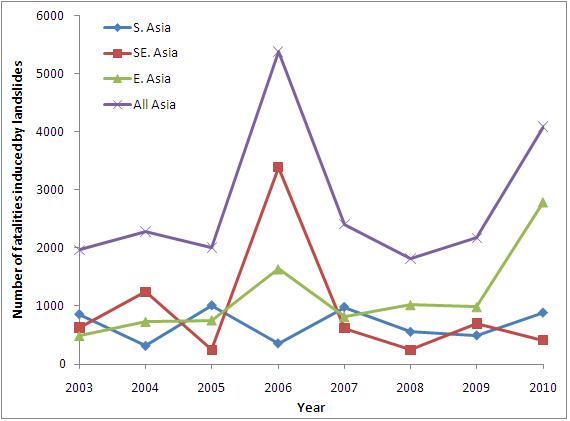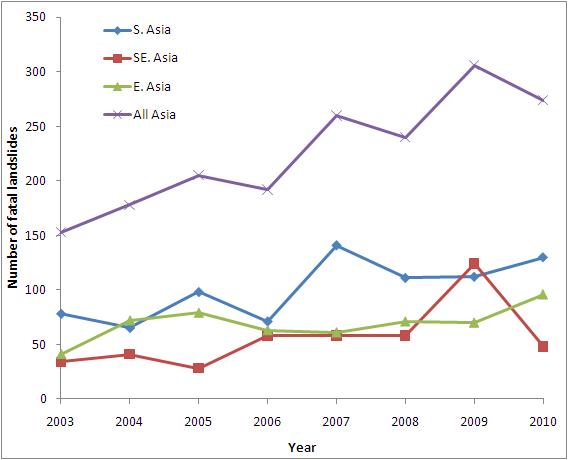24 January 2011
Trends in landslide impacts in Asia
Posted by Dave Petley
Over the weekend I was putting together some data on trends in landslide occurrence over the last few years for a UN Forestry report. This is based on the data that I have been collecting over the last eight years or so on landslides that kill people. I looked first at the number of deaths non-seismic landslides – this graph shows the reported number of people killed per year from 2003 to 2010. Note though that the 2010 data is incomplete, such that the values reported here for that year are an under-estimate:
You’ll see that the data suggests no overall trend in reported losses over this period. The data is very noisy (i.e. there is a huge amount of variation from year to year). You will notice that in this data 2006 stands out as being exceptional – this is dominated by the effects of the Guinsuago landslide in the Philippines (which killed about 1,100 people); the Mount Mayon lahars (also in the Philippines), which killed about 1300 people; and the landsfall of typhoon Bilis in China and Vietnam. Interestingly 2006 was an El Nino year. In 2010 there was another large peak; 2010 was again an El Nino year. This is of course not enough to show that El Nino was responsible for these peaks, but of course there are good reasons why this might be the case. It is also interesting to note though that in 2006 the big spike was in SE. Asia, whereas in 2010 this was in E. Asia.
The numbers of recorded fatality-inducing landslides shows a rather different trend:
The overall trends are all upwards, markedly so S. Asia. There is no apparent influence of the El Nino – La Nina cycle here. Of course it may be that my abilities to collect data are improving, giving an apparent upward trend, but I don’t think that this is all of the picture here (I have looked in some detail at the magnitude – frequency relationships of this data, which suggest that the trend is real). Thus, the number of landslides that kill people does seem to be increasing with time in Asia; the key questions that arise are why and how we can effectively act to reduce this trend.




 Dave Petley is the Vice-Chancellor of the University of Hull in the United Kingdom. His blog provides commentary and analysis of landslide events occurring worldwide, including the landslides themselves, latest research, and conferences and meetings.
Dave Petley is the Vice-Chancellor of the University of Hull in the United Kingdom. His blog provides commentary and analysis of landslide events occurring worldwide, including the landslides themselves, latest research, and conferences and meetings.
[…] This post was mentioned on Twitter by Gunnar Ries, Chris Rowan. Chris Rowan said: Trends in landslide impacts in Asia http://bit.ly/i5H1iB […]
To the question of why: Could population growth and / or sprawl away from cities play a factor?